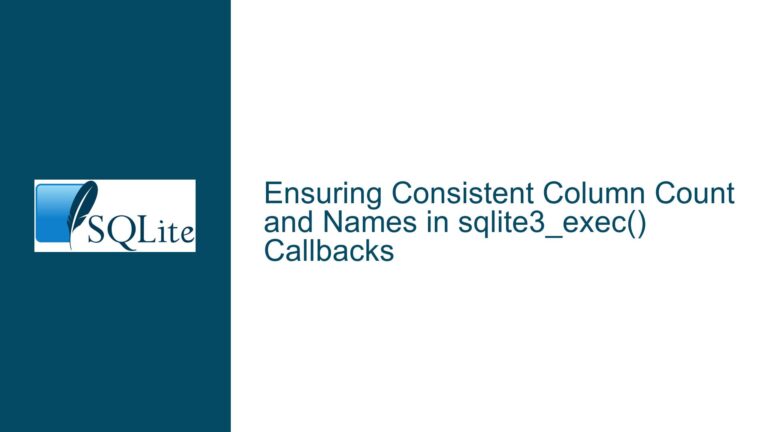Incorrect MAX/MIN Aggregation on SQLite Virtual Tables from CSV
Virtual Table Aggregation Yields Last Row Value Instead of MAX/MIN
The core issue revolves around the incorrect behavior of aggregate functions, specifically MAX() and MIN(), when applied to a virtual table created from a CSV file in SQLite. Instead of computing the correct maximum or minimum value from the column, the query consistently returns the value from the last row of the CSV file. This behavior is observed regardless of the actual data distribution or the logical expectation of the aggregate function. For example, when executing SELECT MAX(x) FROM text;, where text is a virtual table created from a CSV file, the result is the value of x from the final row of the CSV, rather than the true maximum value in the column.
This issue is particularly problematic because it undermines the reliability of aggregate functions, which are fundamental to data analysis and reporting tasks. The problem is not limited to the MAX() function; the MIN() function exhibits the same behavior, returning the value from the last row instead of the minimum value. This suggests a systemic issue in how SQLite processes aggregate functions on virtual tables derived from CSV files.
To illustrate, consider the following CSV file (test.csv):
1,1
4,4
3,3
2,2
1,1
8,8
7,7
When a virtual table text is created from this CSV and queried with SELECT MAX(x) FROM text;, the result is 7, which corresponds to the last row’s x value, rather than the expected maximum value of 8. Similarly, SELECT MIN(x) FROM text; also returns 7, further confirming the anomaly.
Misaligned Virtual Table Indexing and Aggregate Function Processing
The root cause of this issue lies in the interaction between SQLite’s virtual table mechanism and the processing of aggregate functions. Virtual tables in SQLite are implemented through modules that define custom behavior for operations like scanning, filtering, and indexing. In the case of the CSV virtual table, the module is responsible for reading the CSV file and presenting its contents as a table. However, the implementation appears to mishandle the aggregation logic, particularly for MAX() and MIN() functions.
When SQLite processes an aggregate query on a virtual table, it relies on the virtual table module to provide the necessary data in a way that aligns with the aggregation logic. In this case, the CSV virtual table module fails to correctly iterate through the rows and apply the aggregation logic. Instead, it seems to process only the last row, leading to the incorrect result. This behavior is evident from the query execution plan, which shows that the virtual table is being scanned, but the aggregation step is not correctly applied across all rows.
The issue is further compounded by the fact that the virtual table’s indexing mechanism does not align with the requirements of aggregate functions. While the query plan indicates that the virtual table is being scanned, the aggregation step is not correctly integrated into the scan. This misalignment results in the aggregation function being applied only to the final row, rather than across all rows as intended.
Resolving the Issue with Virtual Table Module Updates and Workarounds
The issue was ultimately resolved by a fix in the SQLite source code, specifically in the virtual table module responsible for handling CSV files. The fix ensures that aggregate functions like MAX() and MIN() are correctly applied across all rows of the virtual table, rather than being limited to the last row. This fix was implemented in the SQLite source code and is available in versions following the check-in 54b54f02c66c5aea.
For users who cannot immediately upgrade to a version of SQLite that includes this fix, there are several workarounds available. One effective workaround is to use a subquery to explicitly order the rows before applying the aggregate function. For example:
SELECT MAX(x) FROM (SELECT x FROM text ORDER BY x);
This approach forces SQLite to process all rows in the correct order, ensuring that the aggregate function is applied as expected. Another workaround is to create a temporary view or table that explicitly orders the data:
CREATE TEMPORARY VIEW vtext AS SELECT * FROM text ORDER BY x;
SELECT MAX(x) FROM vtext;
Both of these methods ensure that the aggregation logic is correctly applied across all rows, providing accurate results even in the absence of the fix.
In conclusion, the issue of incorrect MAX() and MIN() aggregation on virtual tables derived from CSV files in SQLite stems from a misalignment between the virtual table’s indexing mechanism and the aggregation logic. This issue has been resolved in recent versions of SQLite, but users of older versions can employ workarounds involving subqueries or temporary views to achieve correct results. By understanding the underlying cause and applying the appropriate fixes or workarounds, users can ensure the reliability of their aggregate queries on virtual tables.






